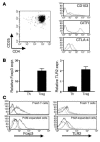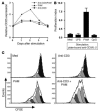Toll-like receptor 2 controls expansion and function of regulatory T cells
- PMID: 16424940
- PMCID: PMC1332026
- DOI: 10.1172/JCI25439
Toll-like receptor 2 controls expansion and function of regulatory T cells
Abstract
Tregs play a central role in the suppression of immune reactions and prevention of autoimmune responses harmful to the host. During acute infection, however, Tregs might hinder effector T cell activity directed toward the elimination of the pathogenic challenge. Pathogen recognition receptors from the TLR family expressed by innate immune cells are crucial for the generation of effective immunity. We have recently shown the CD4CD25 Treg subset in TLR2 mice to be significantly reduced in number compared with WT littermate control mice, indicating a link between Tregs and TLR2. Here, we report that the TLR2 ligand Pam3Cys, but not LPS (TLR4) or CpG (TLR9), directly acts on purified Tregs in a MyD88-dependent fashion. Moreover, when combined with TCR stimulation, TLR2 triggering augmented Treg proliferation in vitro and in vivo and resulted in a temporal loss of the suppressive Treg phenotype in vitro by directly affecting Tregs. Importantly, WT Tregs adoptively transferred into TLR2 mice were neutralized by systemic administration of TLR2 ligand during the acute phase of a Candida albicans infection, resulting in a 100-fold reduced C. albicans outgrowth. This demonstrates that in vivo TLR2 also controls the function of Tregs and establishes a direct link between TLRs and the control of immune responses through Tregs.
Figures









References
-
- Sakaguchi S. Naturally arising CD4+ regulatory T cells for immunologic self-tolerance and negative control of immune responses. Annu. Rev. Immunol. 2004;22:531–562. - PubMed
-
- Shevach EM. CD4+ CD25+ suppressor T cells: more questions than answers. Nat. Rev. Immunol. 2002;2:389–400. - PubMed
-
- Thornton AM, Shevach EM. Suppressor effector function of CD4+CD25+ immunoregulatory T cells is antigen nonspecific. J. Immunol. 2000;164:183–190. - PubMed
-
- Piccirillo CA, Shevach EM. Cutting edge: control of CD8+ T cell activation by CD4+CD25+ immunoregulatory cells. J. Immunol. 2001;167:1137–1140. - PubMed
-
- Sakaguchi S, Sakaguchi N, Asano M, Itoh M, Toda M. Immunologic self-tolerance maintained by activated T cells expressing IL-2 receptor alpha-chains (CD25). Breakdown of a single mechanism of self-tolerance causes various autoimmune diseases. J. Immunol. 1995;155:1151–1164. - PubMed
Publication types
MeSH terms
Substances
LinkOut - more resources
Full Text Sources
Other Literature Sources
Molecular Biology Databases

